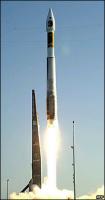







|
News and Information
Mars probe launches at third try
| August 12, 2005 |

Watch the launch
Nasa's Mars probe has launched after two days of delays, on a mission to map and find water on the Red Planet.
The $720m (£397m) Mars Reconnaissance Orbiter (MRO) blasted off at 1243 BST (1143 GMT) on Friday after being delayed for two days running.
A launch attempt on Thursday was scrubbed due to a sensor malfunction.
MRO will arrive at Mars in March on a four-year mission; its cameras will send back the clearest images yet of the planet from space.
"What a difference a day makes," said Nasa launch manager Chuck Dovale. "It couldn't have been any smoother."
The spacecraft is the size of a small bus and weighs about 2,000kg; it will carry some of the most sophisticated instruments ever taken to the Red Planet.
Cameras and spectrometers will enable scientists to study Mars' composition and structure and search for surface features related to water.
MARS RECONAISSANCE ORBITER
1) 3m High-gain antenna
2) High-resolution Imaging Science Experiment
3) Electra UHF communications relay
4) Mars Climate Sounder
5) Compact Reconnaissance Imaging Spectrometer for Mars
6) Orbit insertion thrusters
7) Shallow subsurface radar
8) Thrusters
9) Optical Navigation camera
10) Low-gain antennae
A radar sounder will look for liquid water reservoirs that may exist beneath the surface of Mars.
"A prime goal of ours is to achieve higher spatial resolution in our observations of the surface and of the atmosphere and of the sub-surface by radar," said Richard Zurek, MRO project scientist.
"When you increase your resolution and you still want to cover adequate areas of the planet what you have to be able to do is return much more data than previous missions have done."
As such, MRO is also equipped with the largest communications antenna ever sent to the Red Planet, which will transmit 10 times more data each minute than previous Mars probes. This will allow the robotic probe to serve as a powerful communications relay for future missions to the surface.
Life search
Nasa has adopted the mantra "follow the water" in its approach to robotic exploration of the Red Planet, since water is an essential ingredient for life. One of the scientific objectives of the mission is to investigate whether Mars could once have supported microbial life forms.
Mars Reconnaissance Orbiter, Nasa
Mars Reconnaissance Orbiter will support future surface missions
"Dramatic discoveries, about recent gullies, near-surface permafrost and ancient surface water have given us a new Mars in the past few years," said Michael Meyer, Mars exploration chief scientist.
"Learning more about what has happened to the water will focus searches for possible Martian life, past or present."
The US space agency mission could also reveal what happened to lost Mars landers such as the British-built Beagle 2 probe, which was lost in 2003, and the US Mars Polar Lander, which disappeared in 1999.
Professor Colin Pillinger, from the Open University, who led the Beagle 2 mission, said: "If we could just see some trace of it on the surface then at least we could see how far it got - the not knowing is the worst bit.
"It will be a very difficult thing to do, but this is our best chance of finding out what happened and we will be watching the progress of the mission with great interest and anticipation."
Future plans
Thursday's attempt was abandoned because sensors that monitor fuelling of the rocket were giving a "dry" reading even though the rocket was being filled with hydrogen propellant.
A scheduled lift-off on Wednesday was scrubbed after a gyroscope of the type used in the Atlas V failed while being incorporated into a rocket unrelated to the MRO mission.
MRO will join two operational US orbiters - the Mars Global Surveyor and Mars Odyssey - and one European orbiter, Mars Express, at the Red Planet.
Two US robotic rovers, Spirit and Opportunity, have been on the Martian surface for the past 18 months, investigating the geology of Mars.
Nasa is planning two further Mars missions this decade: the Phoenix module, set for launch in 2007, and Mars Science Laboratory in 2009. |
Source: www.bbc.com |
| http://news.bbc.co.uk/2/hi/science/nature/4134300.stm |
|
| Support Caprivi Freedom |
Fill out the form below to become a member of this site and receive our regular newsletter.
|

|

